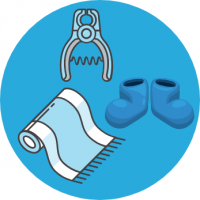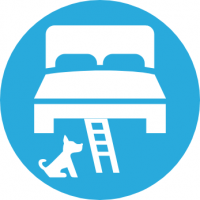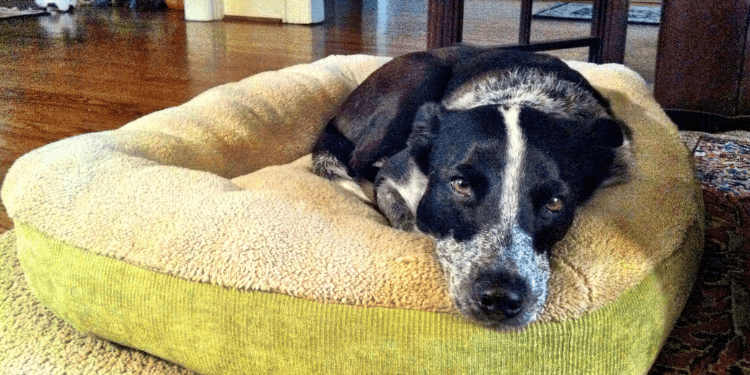The carefree run that becomes a slow shuffle… the defeated look at the bottom of the stairs… the deep groans when settling into bed… the signs of arthritis in an older dog are enough to tug at any loving pet parent’s heart.
It can be easy to feel helpless as you observe the things your arthritic dog used to love become more and more difficult. Luckily, there are several small adjustments you can make to create a big difference in your pup’s quality of life. And what better place to start than where they spend the most time – your home.
Comfort Is Key
When it comes to pet-proofing your house for your arthritic dog, your pup’s comfort should be your #1 priority. Here are the 6 main areas of your home to consider:
 Flooring
Flooring
Do you have hardwood or tile floors in your home? If getting up and walking around is already difficult for your pup, doing so on slick flooring poses even more of a challenge. But before your lay wall to wall carpet, try one of these quick fixes to help your dog get a grip:
- Lay out area rugs or carpet runners (be sure to put anti-skid mats underneath)
- Get a set of socks/booties for your dog to help them grip slippery flooring and prevent skidding
- Give your dog regular nail trims (done either yourself or at a groomer) to help with mobility and increase comfort
 Stairs
Stairs
If you have a two-story home, you’ve seen just how difficult it is for an arthritic dog to navigate your staircase. Adding non-slip stair treads to hardwood staircases can make the climb much easier on your dog’s joints. If making it up the stairs is out of the question for your pup, consider getting a support harness so you can easily help carry them up without breaking your back. We are big fans of the Help’EmUp harness.
 Bedding
Bedding
Pay close attention to where your arthritic dog sleeps at night, making sure to give their joints some extra TLC with especially well-cushioned bedding. Try an orthopedic or memory foam dog bed, and replace their beds regularly as they start to wear down. You can also add extra blankets to your pup’s existing bed for added support. Bonus tip: be sure to keep their food and water bowls within reach of their bed, so they can easily and reliably stay well-fed and hydrated.
 Elevated Surfaces
Elevated Surfaces
Does your pup usually love to hop up on your bed at night or jump in the car for a ride, but just can’t quite seem to make it anymore? Try providing “pet steps” or a ramp with a gradual incline to help them get on and off the bed and couch or into the car. This is another area where a support harness comes in handy, providing the help you both need to keep your dog’s quality of life the best it can be. We recommend the Help’EmUp harness.
 Temperature
Temperature
A good rule of thumb for setting the thermostat at a pleasing temperature for your pup is to keep the house as cool or warm as would be comfortable for you. Cold temperatures can lead to greater inflammation in your dog’s joints (which equals greater discomfort) and hot weather can put a strain on their system by forcing their bodies to work overtime to keep them cool. This goes for anywhere your dog spends time – make sure there’s plenty of shade in the backyard or place a small heater in the garage if you need to. If it’s especially cold, your arthritic dog would appreciate a heating pad in their bed (just be sure to slip it in the lining or somewhere it won’t burn them).
 Nutrition
Nutrition
One of the easiest ways to help your arthritic dog is to simply start with their bowl. Providing quality preventative supplements with important active ingredients makes sure your dog’s body is consistently producing enough of the essential proteins that build and strengthen joints – something it’s able to do less and less on its own as your dog ages, which is what leads to joint issues like arthritis, hip and elbow dysplasia, etc. In addition, anti-inflammatory ingredients help keep chronic inflammation at bay, which is the #1 enemy of healthy joints. Using our veterinarian formulated joint supplement GlycanAid HA and Flexerna Omega our all-natural most potent anti-inflammatory will do wonders to keep your dog comfortable and happy.

When it comes down to it, many of these changes are simply common sense that can make a world of difference in the quality of your arthritic pet’s life. But your dog can’t make these shifts themselves – it’s up to you to be an advocate for their health and happiness.



 Flooring
Flooring Stairs
Stairs Bedding
Bedding Elevated Surfaces
Elevated Surfaces Temperature
Temperature Nutrition
Nutrition







